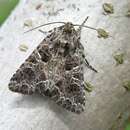en
names in breadcrumbs


Hadena is a genus of moths of the family Noctuidae erected by Franz von Paula Schrank in 1802. About fifteen species are native to North America, while over one-hundred are distributed in the Palearctic realm.[2]
Their eyes are hairy. Palpi upturned and clothed with long hairs. Third joint short. Antennae of male ciliated. Thorax squarely scaled and flattened. Abdomen with dorsal tufts on proximal segments. Tibia lack spines. Wings are short and broad. Hindwings with veins 3 and 4 from cell or on a very short stalk.[3]
Hadena larvae often feed on the seeds of plants in the family Caryophyllaceae, the pinks, and some of the adult moths are pollinators of Silene species.[4] Hadena moths have hairy eyes.[2]
There are about 143[4] to 149 species[2] in the genus.
Zeteolyga was a genus of moths of the family Noctuidae; it is now considered to be a synonym of Hadena.
Hadena is a genus of moths of the family Noctuidae erected by Franz von Paula Schrank in 1802. About fifteen species are native to North America, while over one-hundred are distributed in the Palearctic realm.